Sculpture, Carvings & Other
Browse our stock of antique sculpture and carvings including a wide range of busts, stone sculpture, plaques and key stones in a range of materials like stone, wood, cast iron and terracotta.
-
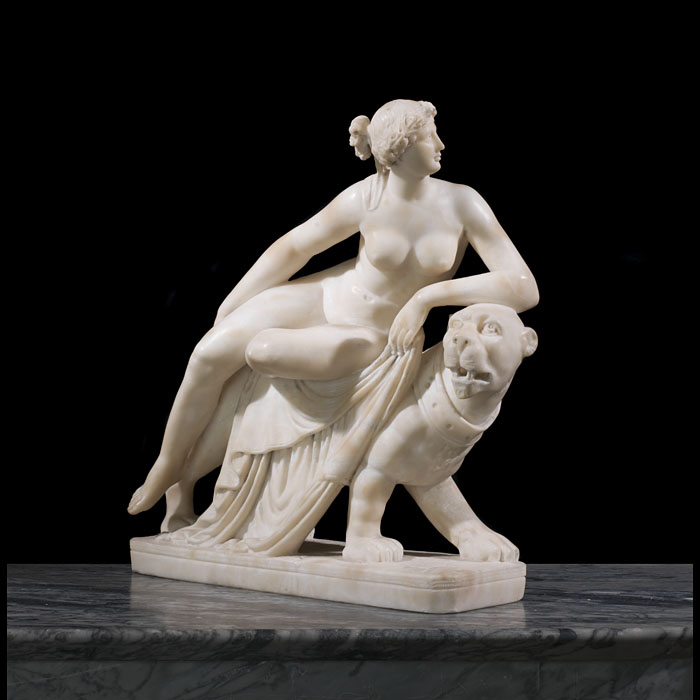 Sold
Sold
Stock: 16269
A fine alabaster figure of Ariadne and the Panther, after the marble sculpture by Johann Heinrich Dannecker, which was one of the most renowned works of sculpture of the nineteenth-century, drawing huge crowds to view it in Frankfurt, in the "Ariadneum" built solely for its display.
It depicts the Cretan princess Ariadne, wife of the god of wine Dionysus (identified by her crown of vine leaves), seated on a panther in a relaxed pose. The panther was a creature associated with the god of wine.
English, c.1860.
View our collection of: Antique sculptures, carvings, bronzes, plaques and tablets
|
Width |
Height |
Depth |
| External |
10 5⁄8"
27 cms |
11 13⁄16"
30 cms |
3 7⁄8"
10 cms |
|
|
|
|
-
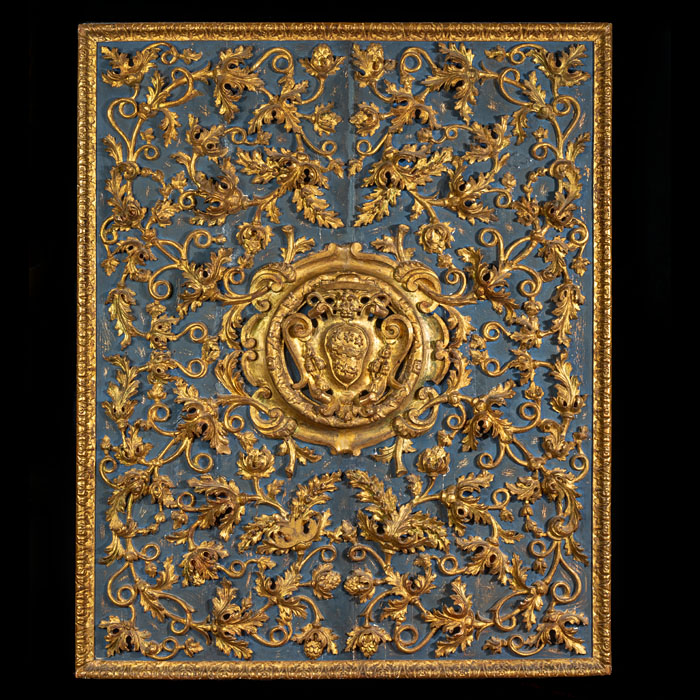 Sold
Sold
Stock: 16243
A large Continental carved gilt wood panel the central carved aromorial cartouche surrounded by carved acanthus leaves and vines, on a blue painted background.
French, mid-18th century.
This panel would look stunning over a fireplace, or even mounted on the ceiling.
View our collection of: decorative antiques and furnishings
|
Width |
Height |
|
|
53 1⁄2"
136 cms |
67 1⁄4"
171 cms |
|
|
|
|
|
-
 Sold
Sold
Stock: 4506
A weathered carved stone bust of Moliere, the 17th century French playwright (1622 - 1673) looking to dexter.
French, circa 1720.
Link to: Antique sculptures, carvings, plaques, tablets, coats of arms and panels
|
width |
height |
|
|
21"
53.3 cms |
25"
63.5 cms |
|
|
|
|
|
-
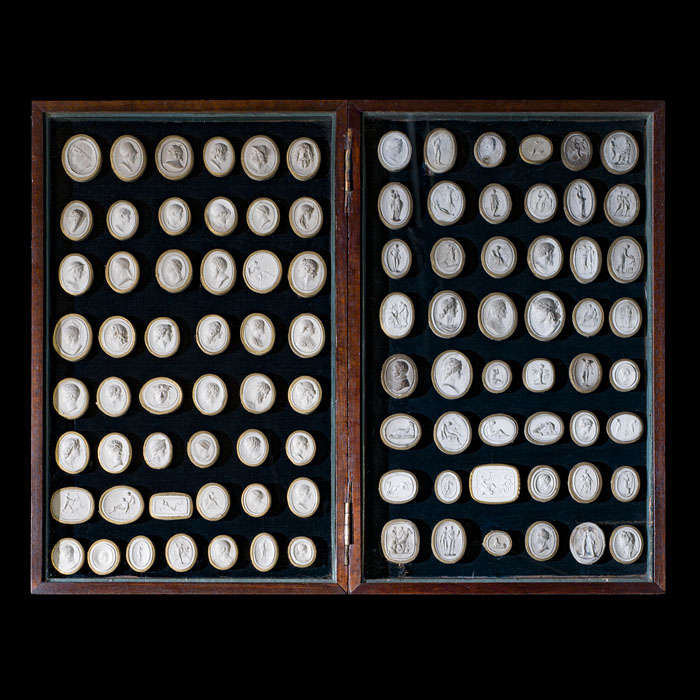 Sold
Sold
Stock: 15877
A rare set of plaster intaglios by Nathaniel Marchant. Originally, this set of casts of Nathaniel's gems was sold by subscription with the accompanying catalogue, published in 1792. It is rare to have a collection of any great quantity, this set is complete, bar four intaglios which are not present. They are mounted within their original ebony strung, mahogany case, which is glazed and fashioned as a book, complete with remnants of marbling. When the spine is removed, the interior is revealed.
Complete sets are exceptionally rare, and one set is held at the John Soane Museum, purchased by Soane in 1793.
English, c.1792.
Nathaniel Marchant (1739-1816) was arguably the most famous gem engraver of the 18th century, prolific in both Italy and England. He was gem sculptor to the Prince of Wales and engraver to The King.
View our collection of: decorative antiques and furnishings.
|
Width |
Height |
Depth |
| Closed |
10"
25.5 cms |
15 3⁄8"
39 cms |
1 13⁄16"
4.6 cms |
| Opened |
19 3⁄8"
49.4 cms |
15 3⁄8"
39 cms |
|
-
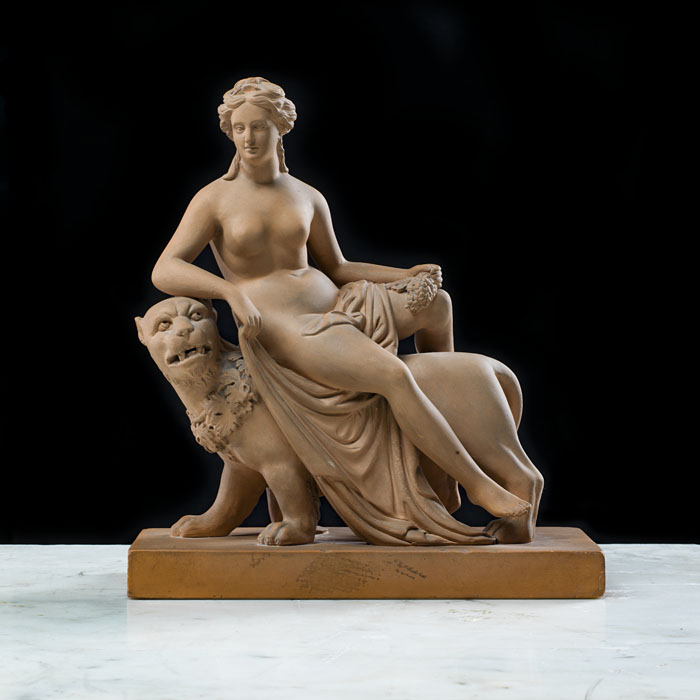 Sold
Sold
Stock: 16069
A terracotta group of Ariadne and the Panther, after the marble sculpture by Johann Heinrich Dannecker, which was one of the most renowned works of sculpture of the nineteenth-century, drawing huge crowds to view it in Frankfurt, in the "Ariadneum" built solely for its display. It depicts the Cretan princess Ariadne, wife of the god of wine Dionysus, seated on a panther in a relaxed pose. The panther was a creature associated with the god of wine, and here, his wreath of vine leaves emphasizes his connection with the deity.
L Hjorth Factory, Danish, c.1880.
Provenance: Coleridge Collection. Anthony Coleridge was well-known in auction circles, a Director of Christie's as well as Chairman and later President of Christie’s South Kensington. He was a keen collector, not just of furniture, but in particular of works of art and ceramics, and he looked after his collection meticulously and recorded it in considerable detail.
Notes: Johann Heinrich Dannecker(1758-1841), a German sculptor who found that the works of classical antiquity made a deep impression on him, as well as the work of Antonio Canova.
The Hjorth Factory was located in Roenne on Bornholm, and island off Denmark, and was founded in 1859.
View our collection of: Antique sculptures, carvings, bronzes, plaques and tablets
|
Width |
Height |
Depth |
|
7 1⁄2"
19 cms |
8 1⁄8"
20.5 cms |
3 3⁄8"
8.6 cms |
|
|
|
|
-
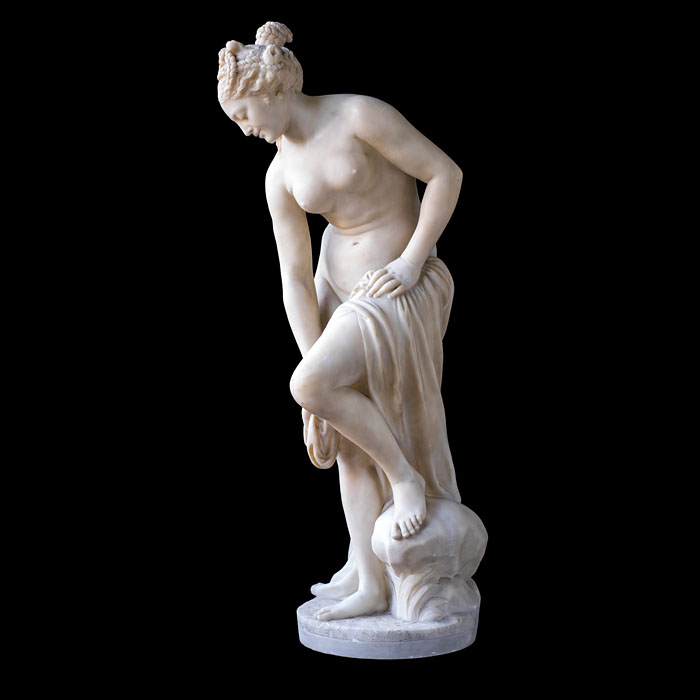 Sold
Sold
Stock: 15912
A large and very finely carved figure of Venus Sortant du Bain, or Venus emerging from her bath. This subject has been immensely popular since classical antiquity, and depicts the Goddess drying herself whilst resting her foot on a rock. This statue would look marvelous on a column or plinth.
This sculpture is after the example made by the French sculptor Christophe-Gabriel Allegrain (French, 1710-1795) for Louis XV in 1755. It was later revered at the Salon of 1767 as a masterpiece. This is now at the Louvre.
French, c.1850.
View our collection of: Antique sculptures, carvings, bronzes, plaques and tablets
|
Width |
Height |
Depth |
|
10 5⁄8"
27 cms |
34 5⁄8"
88 cms |
14 5⁄8"
37 cms |
|
|
|
|
-
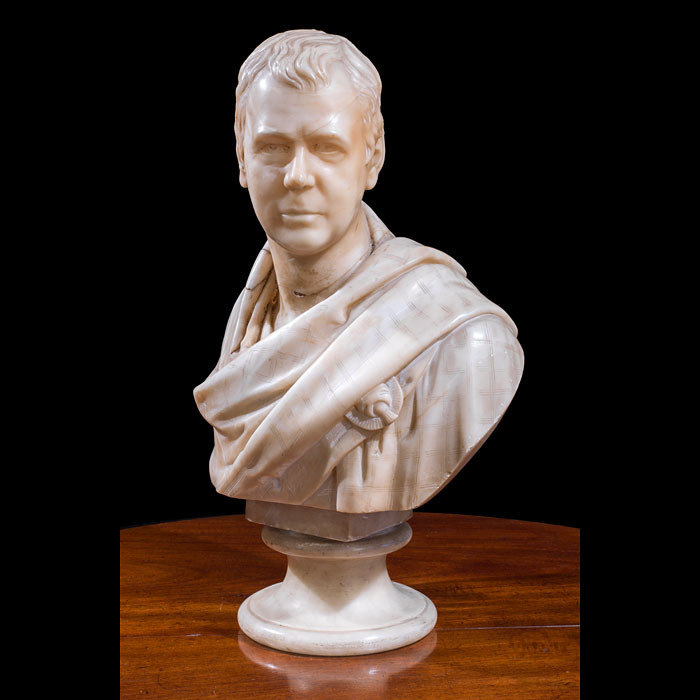 Sold
Sold
Stock: 15764
A rare Scottish 19th century alabaster bust of Sir Walter Scott, after the original by Sir Francis Chantrey. The bust depicts Scott with an intelligent gaze, a lowland plaid over his shoulders.
Scottish, c.1840.
Photograph before restoration.
Notes: Chantrey's original bust was made in 1820 and given to Scott in 1828 'as a token of esteem'. Scott wrote to his wife on 20 March 1820, 'Chantrey's bust is one of the finest things he ever did. It is quite the fashion to go to see it - there's for you' (J. G. Lockhart, Life of Sir Walter Scott, III, p 377)
Sir Francis Chantrey's 1820 bust of Sir Walter Scott portrays the author with his head turned slightly to the right and a Lowland plaid arranged round his shoulders as in this rare copy. James Hogg wrote that 'Sir Walter Scott in his study, and in his seat in the Parliament-house, had rather a dull, heavy appearance, but in company his countenance was always lighted up, and Chantrey has given the likeness of him there precisely' (Domestic Manners of Sir Walter Scott, p. 113.).
View our collection of: Antique sculptures, carvings, bronzes, plaques and tablets
|
Width |
Height |
Depth |
|
13"
33 cms |
20 1⁄2"
52 cms |
8 11⁄16"
22 cms |
|
|
|
|
-
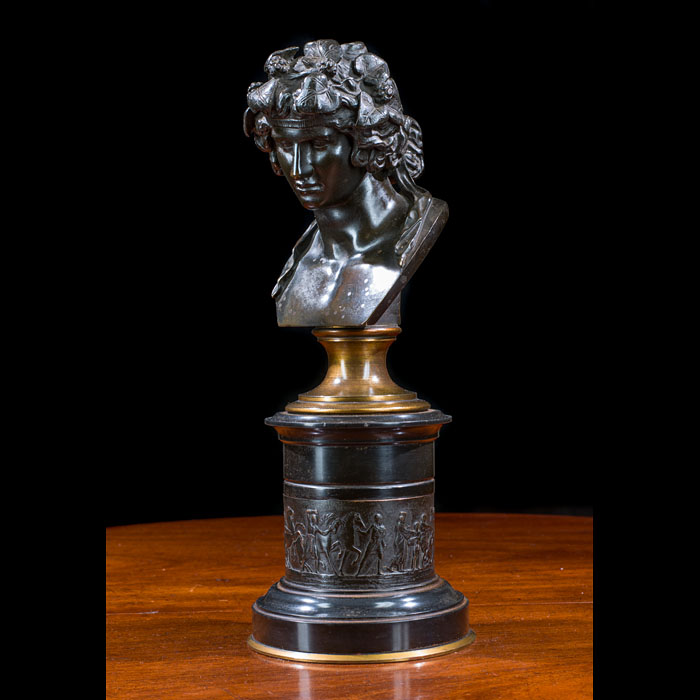 Sold
Sold
Stock: 15779
A fine 19th century bust of Bacchus, or Dionysus. This bronze library bust is modelled on the Landsdowne Antinous - who has assumed the guise of Dionysus - and is mounted on a gilt socle and a bronze banded base cast in low relief with a classical procession.
Italian, c.1890.
Notes: Antinous, the lover and companion of Emperor Hadrian, had one of the most recognisable faces in the Roman Empire. After his sudden death 130 AD, the grief stricken Emperor declared the youth had been reborn as a God. Representations of Antinous assuming the form of a God flooded the visual culture of the Roman Empire, and the Lansdowne Antinous was a larger than life bust which became renowned for its idealised beauty and quality. Antinous' image was commonly asssimilated with the well-known Gods such as Apollo, Mercury and indeed Bacchus. This bust was excavated at Hadrian's villa at Tivoli, and was likely part of a shrine dedicated to the youth.
-
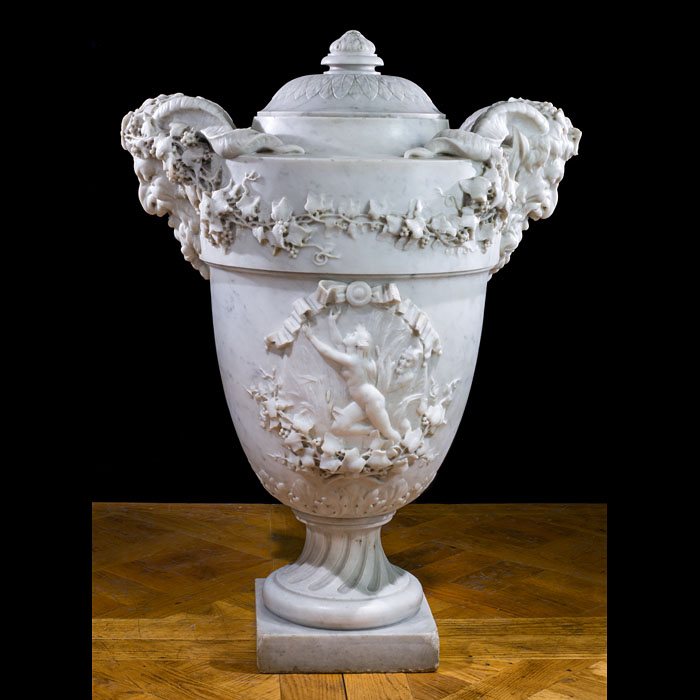 Sold
Sold
Stock: 15724
A large and finely carved 19th century Italian marble lidded urn, decorated with trailing grape vines and and dramatic handles, modelled as grinning and horned satyrs. The body of the urn is carved with two cartouches, one depicting a nymph bathing in a pool whilst a satyr observes, hidden by bullrushes. The other depicts an a satyr and a goat in an amorous and playful embrace. After the antique.
Italian, c.1850.
Could be situated in a sheltered spot in a garden or courtyard, but equally suited to an interior setting.
View our collection of: decorative antiques and furnishings
|
Width |
Height |
Depth |
|
28"
71 cms |
40"
101.5 cms |
19 11⁄16"
50 cms |
|
|
|
|
-
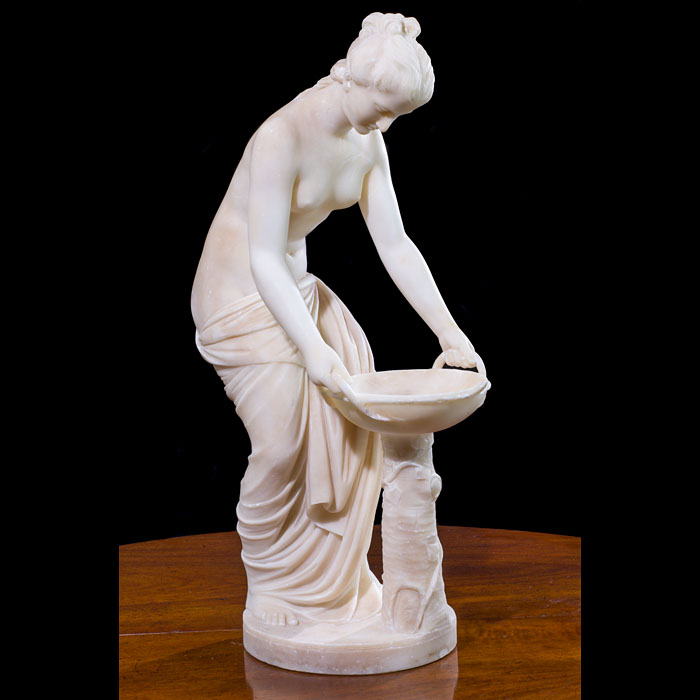 Sold
Sold
Stock: 15641
A large and finely carved alabaster figure of a water carrier in classical drapery. The figure is very much after the antique, but more naturalistic than the earlier, grand tour alabaster figures.
English, c.1860.
-
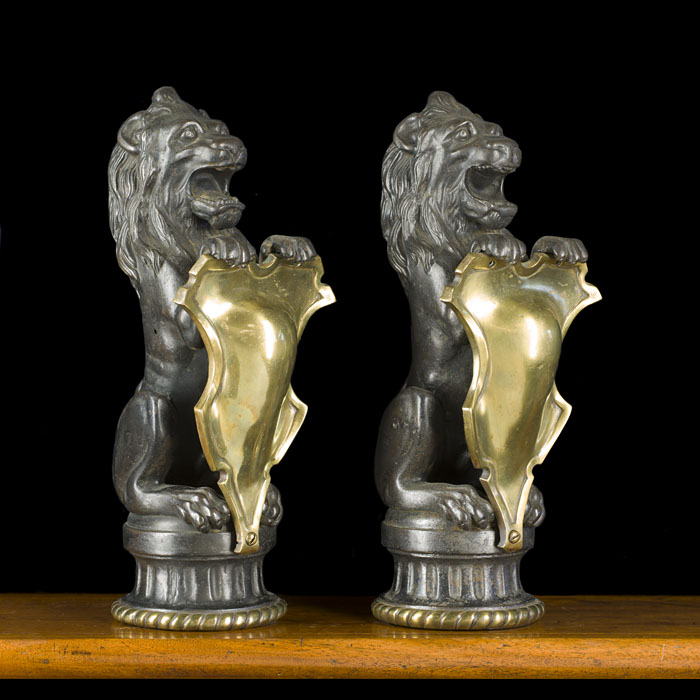 Sold
Sold
Stock: 15622
A pair of large and decorative Victorian cast iron seated lions holding polished brass blank armorial shields. These would look fabulous as decorative objects on a surface, or on a hearth to dress the interior of a fireplace. The shields could even be engraved with a monogram.
English, c.1870
View our collection of: Antique sculptures, carvings, bronzes, plaques and tablets
|
Width |
Height |
Depth |
|
5 3⁄16"
13.2 cms |
13 13⁄16"
35 cms |
5 11⁄16"
14.5 cms |
|
|
|
|
-
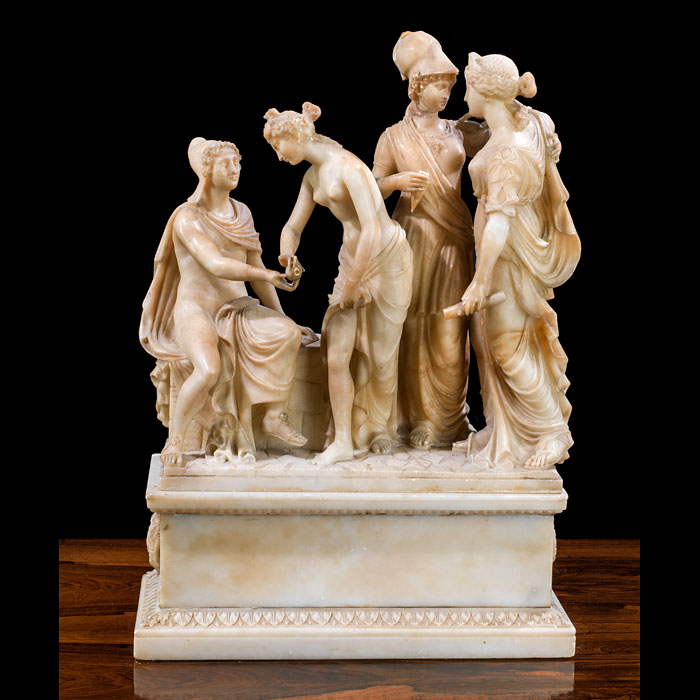 Sold
Sold
Stock: 15558
An exceptionally finely carved and very large alabaster group of the Judgement of Paris, depicting Paris seated and wearing his Phrygian cap, offering the Hesperidean apple to a lightly draped Venus, whilst the jealous figures of Hera and Athena consol each other. The scene is mounted on a rectangular plinth. Italian, mid 19th century.
Photograph before restoration.
Provenance: A collection within a fine Wiltshire Townhouse.
|
Width |
Height |
Depth |
|
15 3⁄8"
39 cms |
21 11⁄16"
55 cms |
6 11⁄16"
17 cms |
|
|
|
|
-
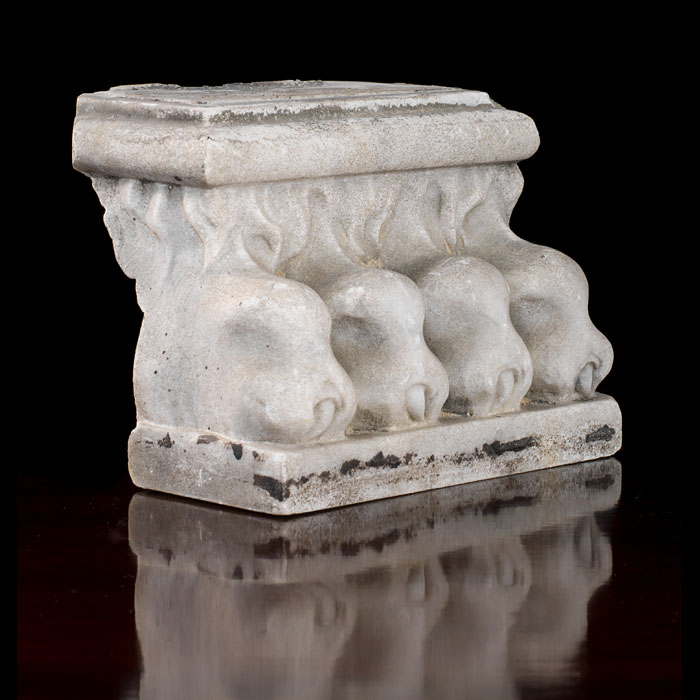 Sold
Sold
Stock: 15390
A small Statuary marble Regency style lion paw sculpture almost certainly once part of a fireplace. English, circa 1860.
Link to: Antique sculptures, carvings, bronzes, plaques and tablets
|
Width |
Height |
Depth |
|
6 3⁄16"
15.8 cms |
4 13⁄16"
12.3 cms |
4 11⁄16"
12 cms |
|
|
|
|
-
 Sold
Sold
Stock: 4196
A pair of small decorative, Statuary marble Regency carved ionic capitals with their original patina. a/f English, early 19th century.
Link to: Antique sculptures, carvings, bronzes, plaques and tablets
|
Width |
Height |
Depth |
|
11"
28 cms |
10"
25.5 cms |
10 3⁄8"
26.5 cms |
|
|
|
|
-
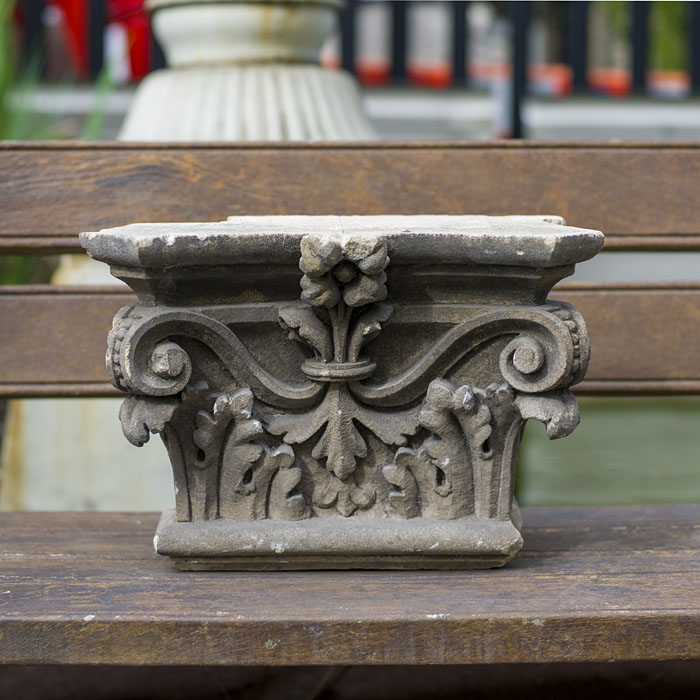 Sold
Sold
Stock: 15393
A limestone architectural capital with acanthus and scrolled carving in the Neoclassical manner. English, 19th century.
Link to: Antique sculptures, carvings, bronzes, plaques and tablets
|
Width |
Height |
Depth |
|
15"
38 cms |
10"
25.5 cms |
7 7⁄8"
20 cms |
|
|
|
|
-
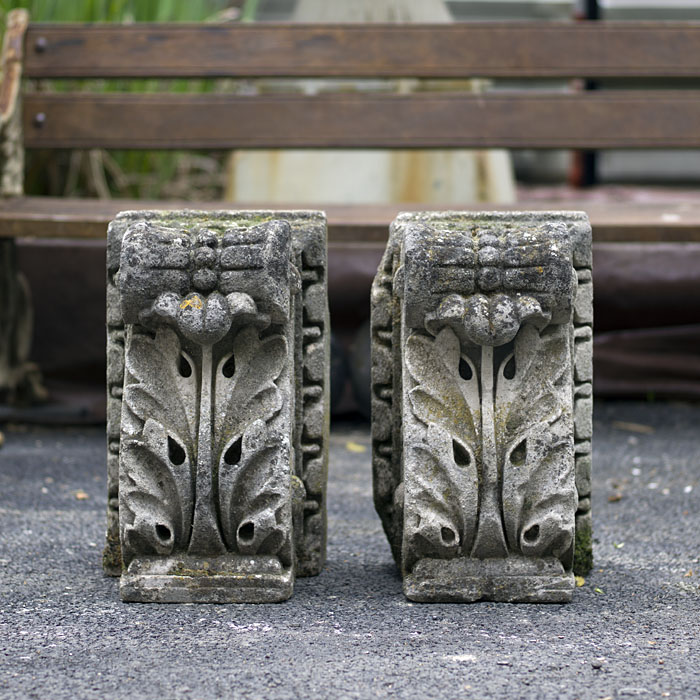 Sold
Sold
Stock: 12744
A pair of architectural Portland Stone c scroll corbels. English, 18th century.
Link to: Antique sculptures, carvings, bronzes, plaques and tablets
|
Width |
Height |
Depth |
|
10 3⁄16"
26 cms |
17 1⁄4"
44 cms |
11"
28 cms |
|
|
|
|
-
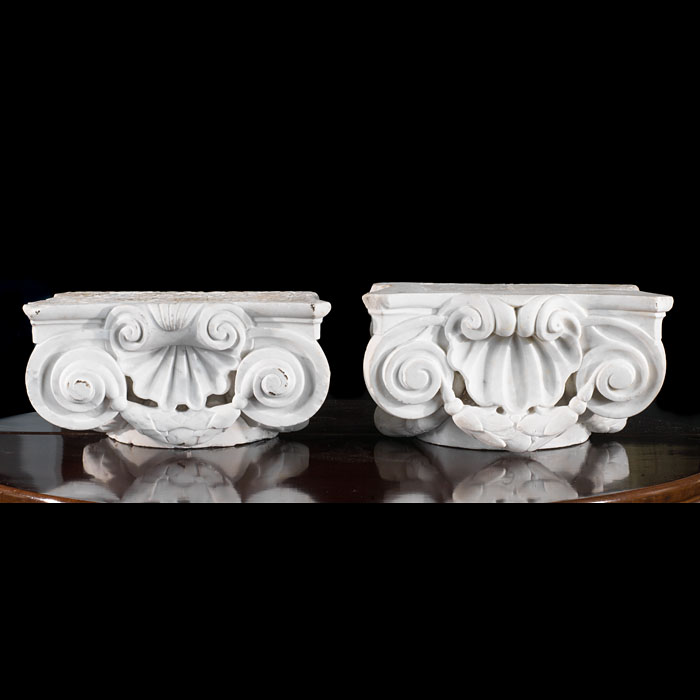 Sold
Sold
Stock: 15391
A near pair of ornamental statuary marble ionic capitals with scrolled shell cartouche in the Georgian style. Probably once part of the columns on a fireplace surround.
English, circa 1860.
Link to: Antique sculptures, carvings, bronzes, plaques and tablets
|
Width |
Height |
Depth |
| Left |
11"
28 cms |
5 3⁄8"
13.6 cms |
5 1⁄2"
14 cms |
| Right |
11"
28 cms |
5 13⁄16"
14.8 cms |
|
-
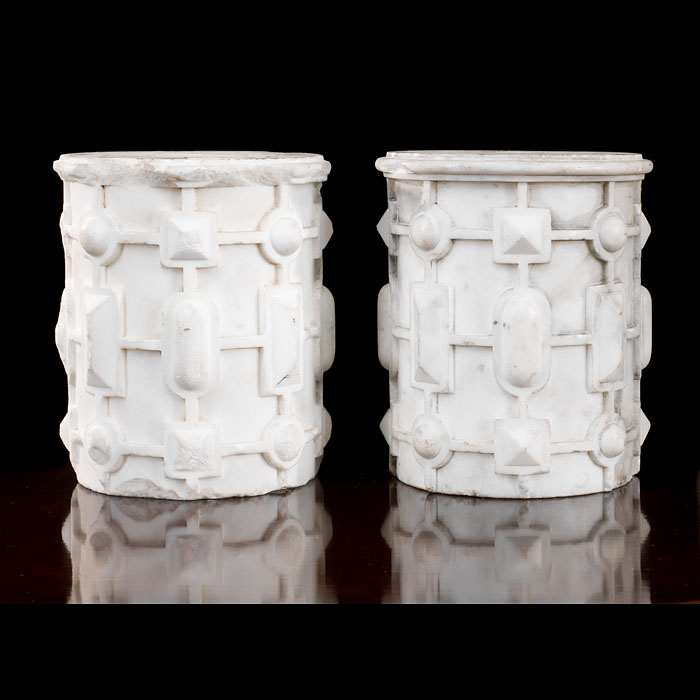 Sold
Sold
Stock: 11140
A pair of ornamental Statuary marble collars or plinths in the Jacobean style with strapwork and lozenge carving. Probably once part of a pair of chimneypiece columns.
English, mid 19th century.
Link to: Antique sculptures, carvings, bronzes, plaques and tablets
|
width |
height |
depth |
|
7 1⁄8"
18 cms |
10 5⁄8"
27 cms |
5 11⁄16"
14.5 cms |
|
|
|
|
-
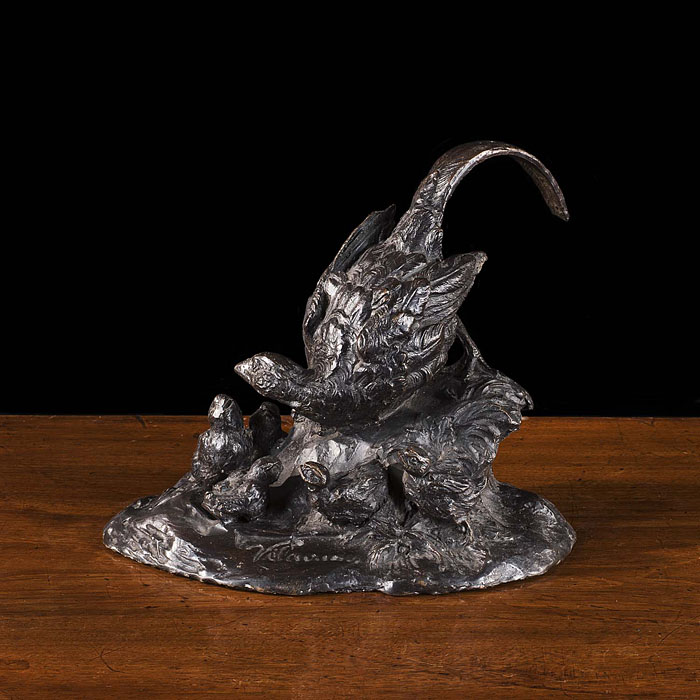 Sold
Sold
Stock: 12051
A small bronze, Art Nouveau model of a pheasant tending her chicks. English, circa 1860.
Link to: Antique sculptures, carvings, bronzes, plaques and tablets
|
Width |
Height |
depth |
|
10 3⁄16"
26 cms |
7 1⁄8"
18 cms |
6 1⁄4"
16 cms |
|
|
|
|
-
 Sold
Sold
Stock: 7237
A single Statuary marble ornamental Corinthian capital in the Neoclassical style with carved rosettes and acanthus leaf detail.
English, 19th century.
Link to: Antique sculptures, carvings, bronzes, plaques and tablets
|
Width |
Height |
|
|
6 1⁄4"
16 cms |
5 1⁄8"
13 cms |
|
|
|
|
|
-
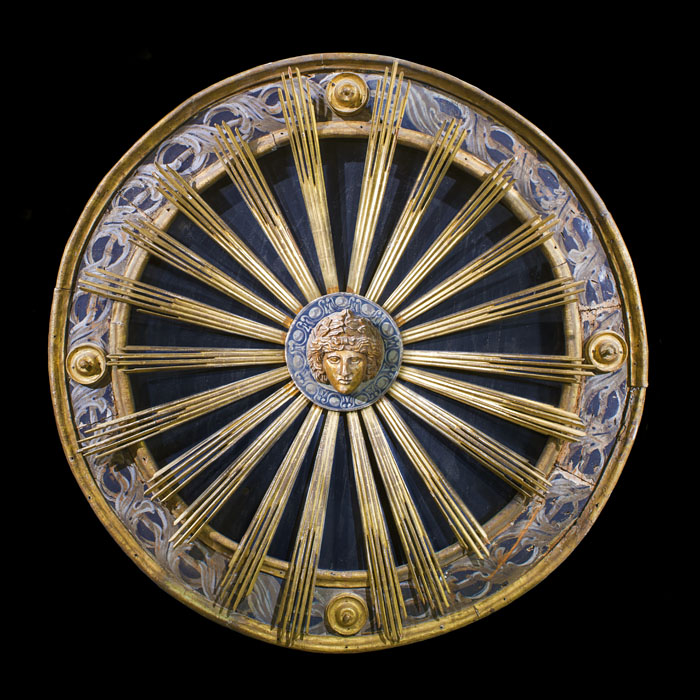 Sold
Sold
Stock: 15298
A large and beautiful antique giltwood sunburst centred by a carved mask, mounted on a trompe l'oeil roundel, of the Greek God Apollo as a personification of the Sun. Radiating out from the mask are twenty two sun rays linked to a giltwood framed circle of further trompe l'oeil set with four giltwood bosses. It is likely to have once been a ceiling adornment in a grand Italian palazzo.
Italian, 18th century or earlier.
Photos before restoration.
Notes: Apollo was a Greek Roman deity and one of the Twelve Olympians. Recognized as a god of archery, music and dance, truth, healing, the Sun and light, poetry and prophecy he was the son of Zeus and Leto, and the twin brother of Artemis, goddess of the hunt.
Link to: Antique sculptures, carvings, bronzes, plaques and tablets
one of the most important and complex of the Olympian deities in classical Greek and Roman religion and Greek and Roman mythology. The national divinity of the Greeks, Apollo has been recognized as a god of archery, music and dance, truth and prophecy, healing and diseases, the Sun and light, poetry, and more. He is the son of Zeus and Leto, and the twin brother of Artemis, goddess of the hunt. Seen as the most beautiful god and the ideal of the kouros (ephebe, or a beardless, athletic youth), Apollo is considered to be the most Greek of all the gods. Apollo is known in Greek-influenced Etruscan mythology as Apulu.[1]
Link to: Antique sculptures, carvings, bronzes, plaques and tablets
|
Diameter |
Depth |
|
|
57 7⁄8"
147 cms |
3 1⁄8"
8 cms |
|
|
|
|
|
-
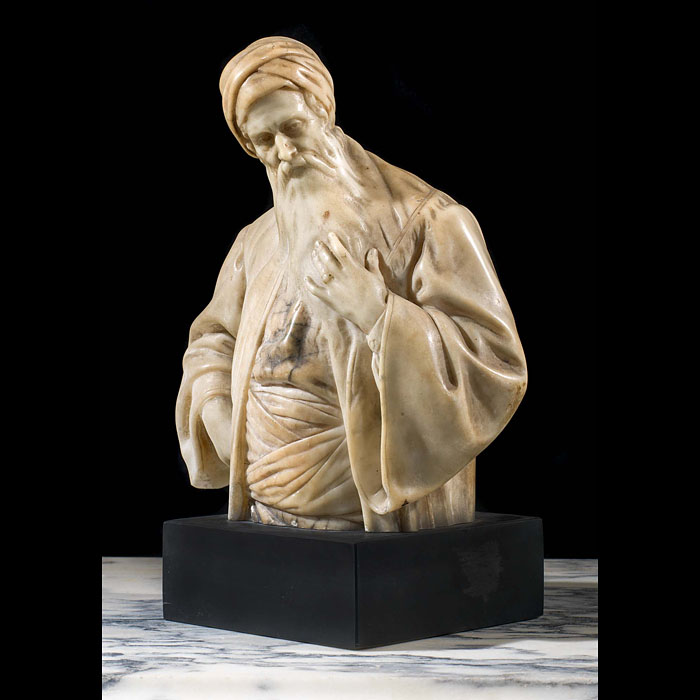 Sold
Sold
Stock: 11475
A small, carved alabaster sculpture of a Middle Eastern gentleman possibly Saladin (the first Sultan of Egypt and Syria), raised on a black marble plinth. The figure may have been cut down from a full size figure please see the last image below.
Early 19th, possibly late 18th century.
View our collection of: Antique sculptures, carvings, bronzes, plaques and tablets
|
|
height without plinth |
height with plinth |
|
|
7 1⁄2"
19 cms |
9 1⁄2"
24.1 cms |
|
|
|
|
-
 Sold
Sold
Stock: 2845
A large 19th century Doulton ceramic pediment plaque of a female head with two putti in the Renaissance manner. Some damage a/f .
English, circa 1860.
Link to: Antique Doors and Windows.
|
Width |
Height |
Depth |
| External |
33 1⁄2"
85 cms |
16 1⁄2"
42 cms |
|
| Internal |
|
|
|
-
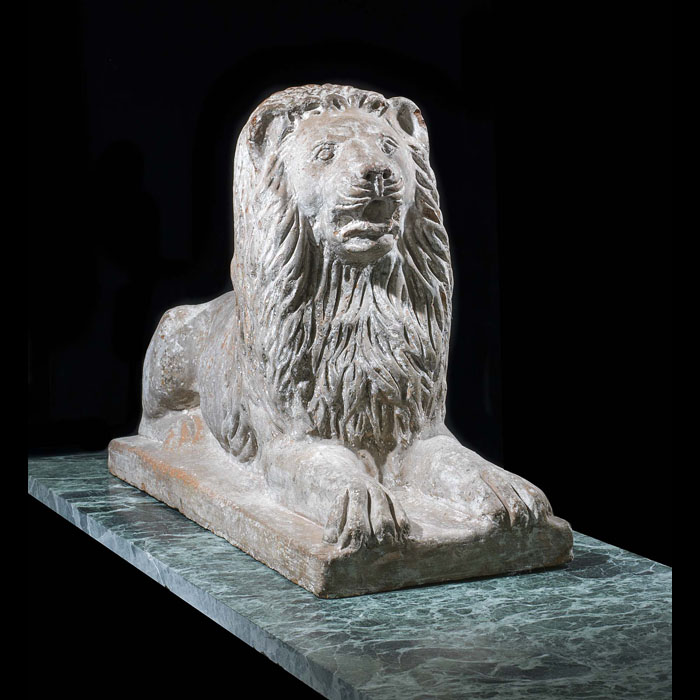 Sold
Sold
Stock: 12900
A small Neoclassical style terracotta garden lion in a recumbent position, rather sphinx like, raised on a rectangular base.
English, circa 1870.
Link to: Antique sculptures, carvings, bronzes, plaques and tablets
|
width |
height |
|
|
24"
61 cms |
16 1⁄8"
41 cms |
|
|
|
|
|
-
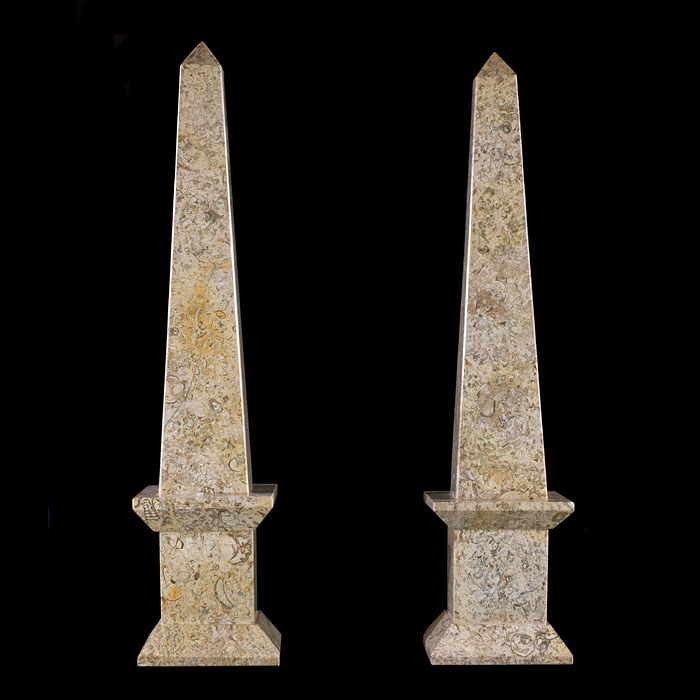 Sold
Sold
Stock: 15224
A striking pair of large ornamental obelisks carved from an exceptional example of softly hued honey and light grey Purbeck Fossil Stone imbued with an abundance of marine fossils including bones, shells, microbes and bivalves and with imprints of early reptiles and animals.
English, circa 1910.
Notes: Purbeck Stone, famous worldwide for the amazing plethora and myriad example of fossils, was laid down during the Upper Jurassic to Lower Cretaceous periods. The name is derived from the Isle of Purbeck in Dorset where outcrops are most prevalent. It is also found in other parts of southern England most notably along the Jurassic Coast, in Dorset, in the strata exposed in the cliffs and on the beaches west of Swanage.
Link to: antique wall tapestries, panels and paintings
|
Width |
Height |
Depth |
|
6 11⁄16"
17 cms |
30 1⁄4"
77 cms |
6 5⁄8"
16.7 cms |
|
|
|
|
-
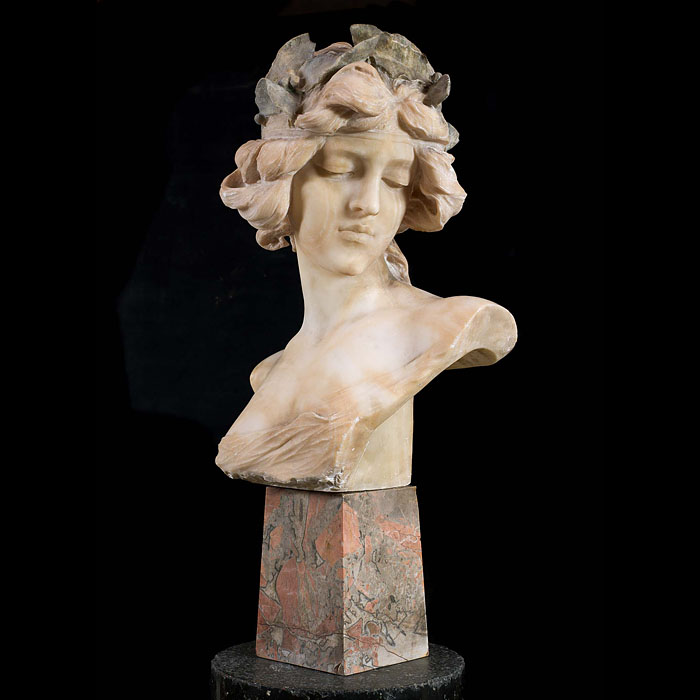 Sold
Sold
Stock: 14987
A charming and finely carved Art Nouveau alabaster bust of a woman with demurely downcast cast eyes. Her casually elegant hairstyle adorned by an entwined leaf wreath and she is raised on a rouge and grey marble base. English or possibly Italian, late 19th century.
Link to: Antique sculptures, carvings, bronzes, plaques and tablets
|
Width |
Height |
Depth |
|
13 3⁄8"
34 cms |
23 5⁄8"
60 cms |
8 11⁄16"
22 cms |
|
|
|
|
-
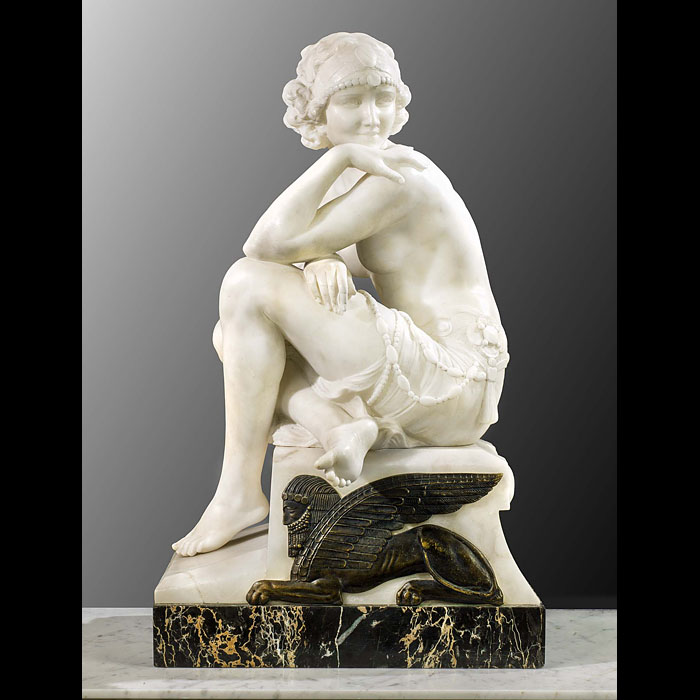 Sold
Sold
Stock: 14431
A rather beautiful Art Deco Statuary Marble figure of a scantily dressed young lady wearing a bejewelled costume and headdress and seated upon an alabaster plinth which has a patinated brass Phoenician Sphinx mounted to the front. The Portoro Marble base bears the inscription L. Morelli, Florence. Italian, circa 1920.
Link to: Antique sculptures, carvings, bronzes, plaques and tablets
|
width |
overall height |
depth |
|
14 3⁄16"
36 cms |
24"
61 cms |
9 1⁄8"
23 cms |
|
|
|
|
-
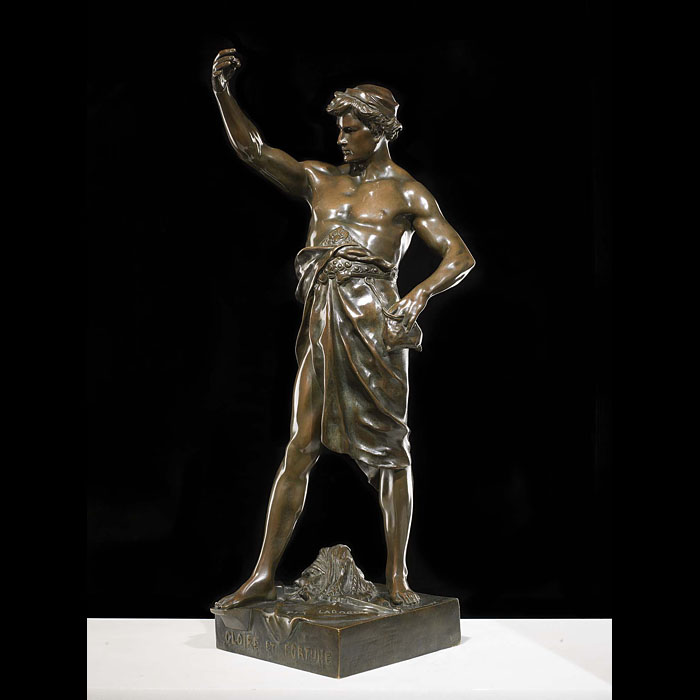 Sold
Sold
Stock: 14252
An antique French bronze figure of a young man with a seed pouch hung from an ornate belt at his waist who would originally have been holding aloft a sprig of wheat now sadly missing. He is standing astride sheaves of wheat, a cog ,a mallet and tools. The title " Per Laborem, Gloire et Fortune ", which loosely translates as Glory and Fortune from the Fruits of Labour, is inscribed on the base together with the name E. Picault who was French sculptor (1833 – 1915) best known for works depicting allegorical and patriotic subjects, and mythological heroes, and a small round stamp with the words " Vrai Bronze, BL , Garanti, Paris". French, late 19th, early 20th century.
Link to: Antique sculptures, carvings, bronzes, plaques and tablets
|
width |
height |
depth |
|
7 1⁄2"
19 cms |
24"
61 cms |
9 1⁄8"
23 cms |
|
|
|
|
-
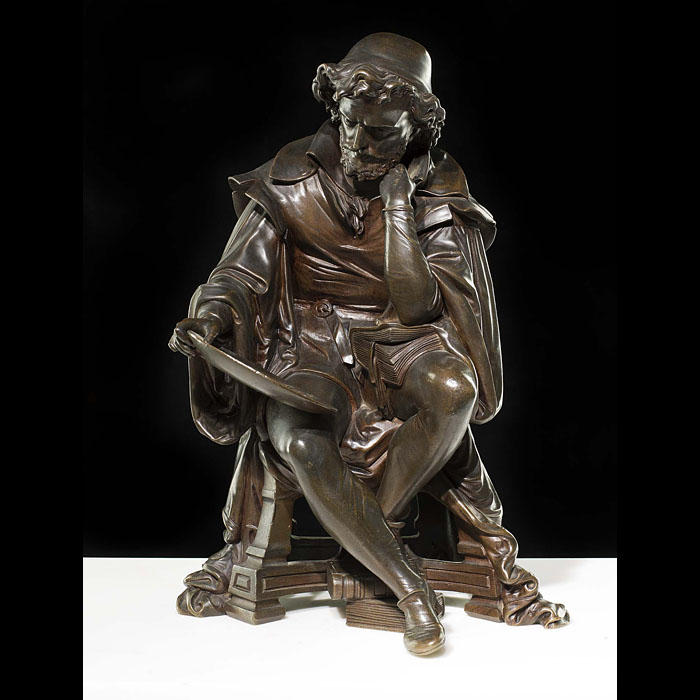 Sold
Sold
Stock: 13872
A 19th century patinated bronze of Leonardo da Vinci, the 15th century Italian Renaissance inventor, painter, sculptor, architect, scientist, musician, mathematician, astronomer and so on - a polymath of his time. He is depicted seated on a stool studying a collection of sea creatures, a crab, an eel, a lobster and fish, displayed on a platter held in his hand. Italian, possibly French, late 19th century.
Link to: Antique sculptures, carvings, bronzes, plaques and tablets
|
width |
height |
depth |
|
9 3⁄8"
24 cms |
14 3⁄16"
36 cms |
8 1⁄4"
21 cms |
|
|
|
|
-
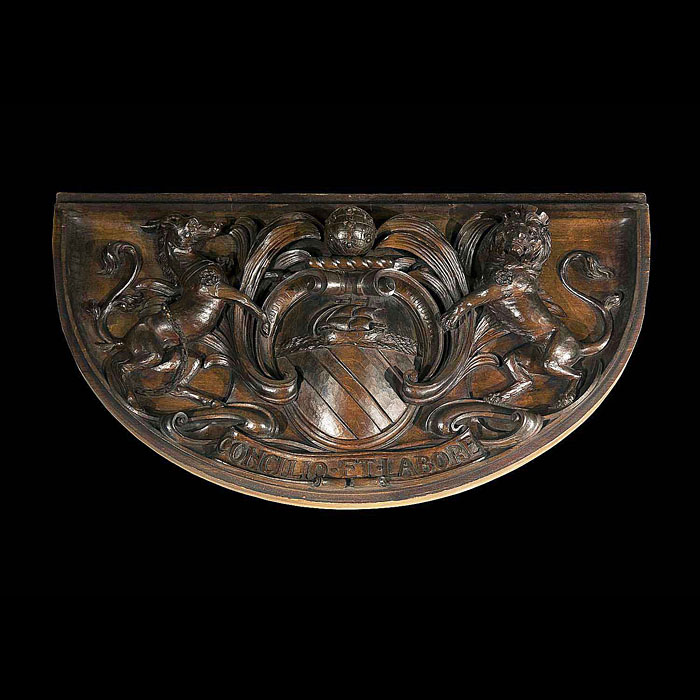 Sold
Sold
Stock: 14383
An antique carved beech wood plaque depicting the Coat of Arms of the City of Manchester which was granted to the City in 1842. The City's motto is inscribed on the plaque and reads "Concilio et Labore" which loosely translated means "Wisdom and Effort".
The Coat of Arms depicts the Heraldic Antelope with its chain, a symbol of peace and harmony, extreme courage and discipline also representing the engineering industries; and the Heraldic Lion a symbol of bravery and strength, his crown, a castle is a reference to the ancient Roman fort of Castlefield. Each wears the Red Rose of Lancaster on their shoulders. They flank a central cabuchon depicting a ship representing the trading relationships of Manchester, and a globe covered in bees which in heraldic terms is a symbol of efficient industry. To this day the bee is often used as a shorthand emblem of Manchester.
English, late 19th century.
Link to: Antique sculptures, carvings, bronzes, plaques and tablets
|
width |
height |
|
|
28 11⁄16"
73 cms |
11 1⁄4"
28.8 cms |
|
|
|
|
|
-
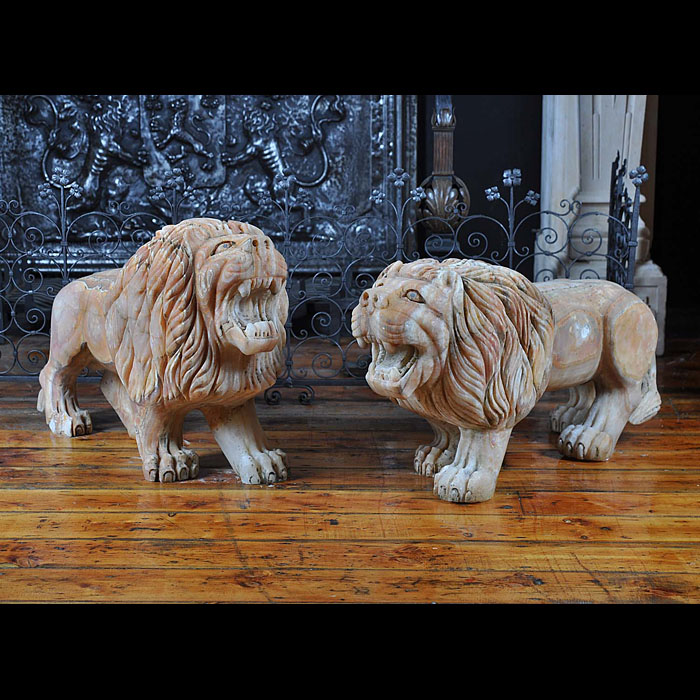 Sold
Sold
Stock: 12333
A pair of small very well carved onyx lions passant very much in the Medeci tradition. Onyx is a banded variety of chalcedony of which agate is the most popular type.
Possibly Italian early to mid twentieth century.
Link to: Antique sculptures, carvings, bronzes, plaques and tablets
|
Width |
Height |
Length |
|
9 13⁄16"
25 cms |
18 7⁄8"
48 cms |
28 1⁄4"
72 cms |
|
|
|
|
-
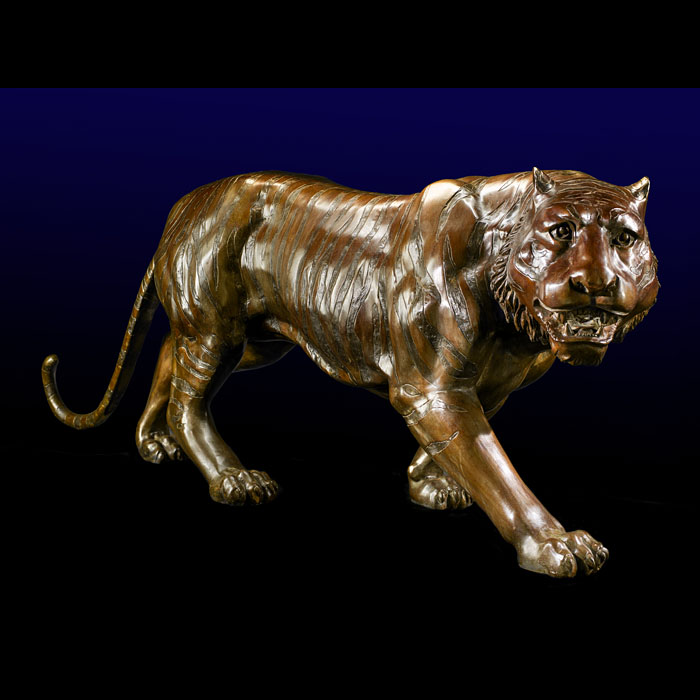 Sold
Sold
Stock: 13742
A grand and finely modelled life size bronze figure of a prowling tiger.
Powerful and Regal.
Probably 20th Century Japanese.
Weight: 90kg
Link to: Antique sculptures, carvings, bronzes, plaques and tablets
|
length |
height |
|
|
77 3⁄16"
196 cms |
26 5⁄8"
67.5 cms |
|
|
|
|
|
-
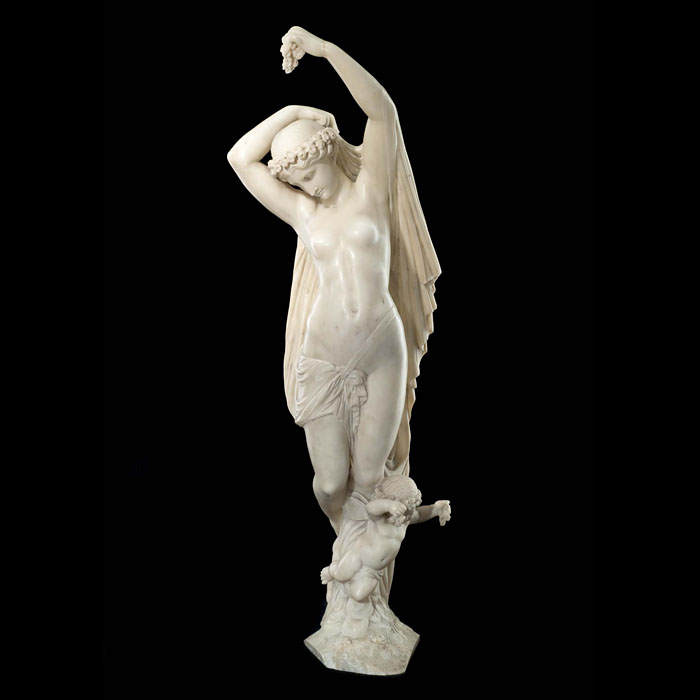 Sold
Sold
Stock: 12724
A beautifully carved alabaster group in the manner of Cesare Lapini (1848 - 1890) an Italian sculptor mainly active in 19th century Florence. A maiden, representing Flora the Roman Goddess of Flowers has a child playing at her feet and both are wearing garlands of roses and clasping flowers.
Italian School 19th century.
Link to: Antique sculptures, carvings, bronzes, plaques and tablets
|
width |
height |
depth |
|
10 5⁄8"
27 cms |
32 11⁄16"
83 cms |
9 13⁄16"
25 cms |
|
|
|
|
-
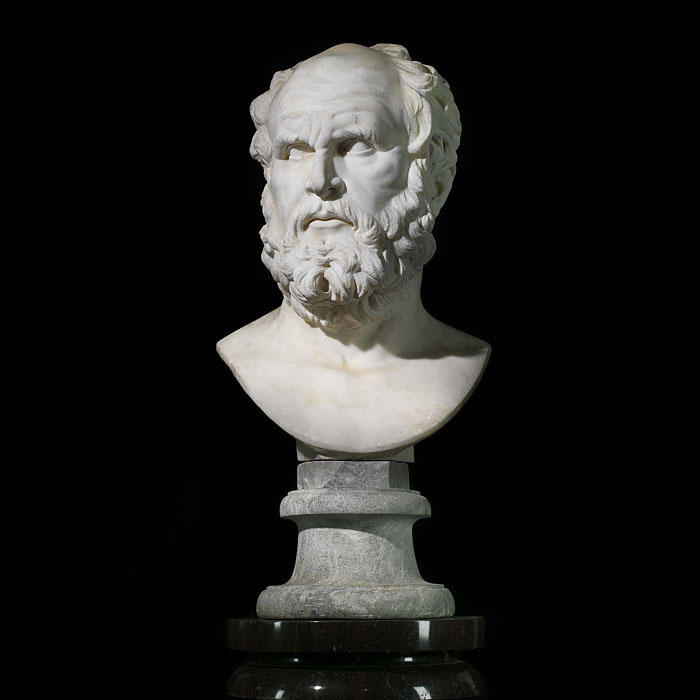 Sold
Sold
Stock: 13391
A very fine life size marble bust, mounted on a composition coadestone base, of a Greek/Roman philosopher, most probably Plato or perhaps Socrates. Originally from a property in County Durham.
Link to: Antique sculptures, carvings, bronzes, plaques and tablets
|
Width |
Height |
Depth |
|
11 13⁄16"
30 cms |
24"
61 cms |
9 3⁄8"
24 cms |
|
|
|
|
-
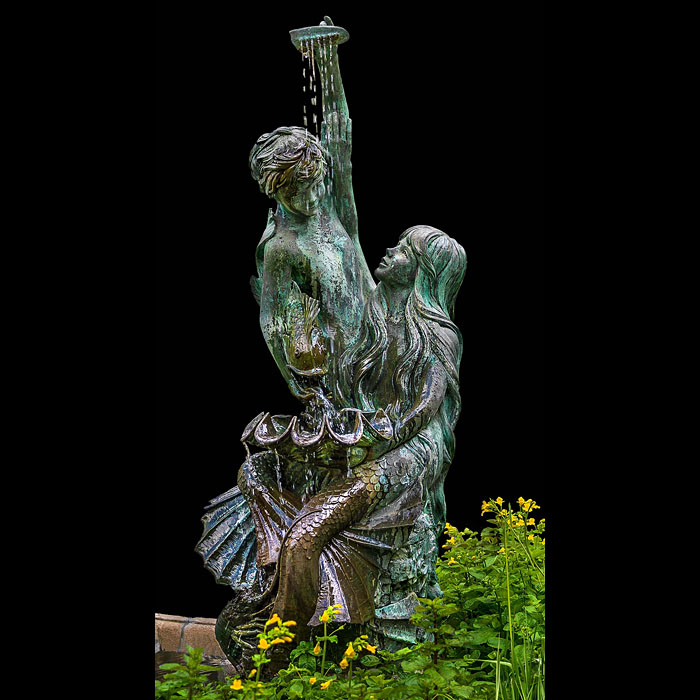 Sold
Sold
Stock: 13526
A rare Bronze Fountain Group attributed to David Rawnsley (1909- 1977).
Sculptor, Painter, Ceramicist, Film Art Director & Production Designer.
A delightful, unique and beautifully sculpted Fountain of an entwined Mermaid & Merboy resting on rocks by the sea, both are twin tailed. The Merboy holds a large fish from whose mouth a water spout falls into the clam shell beneath. There is another water spout emanating from the abalone shell held above his head. The Mermaid is holding the clam shell in which lies a large starfish. A crab, a lobster and an octopus are climbing the rock beneath and nearby are limpets and coral.
Mermaids & Merboys are legendary figures appearing throughout the centuries in the folklore of many cultures and traditionally could symbolise either danger or good fortune. This pair are of course beneficent. English, circa 1960.
Notes: David Rawnsley was in his own words 'a jack of all trades'. Initially trained as an architect and engineer he entered the film industry in his early twenties as an art director & production designer. Film credits include: 49th Parallel, One of Our Aircraft is Missing, They Flew Alone and In Which We Serve. In the 40's and 50's he started up a series of potteries. The first in Paris was followed by the famous Chelsea Pottery in London in 1952 and later by one in the Bahamas and another in Mexico. His sister Una Hanbury (1904 – 1990) was a renowned Washington sculptor of horses and Rawnsley himself became an acknowledged artist and sculptor. His parents had settled the Rawnsley family on the Isle of Capri in the 1920's and in later years he set up a studio there. During a short visit in 1977 he died of a heart attack and he is buried on the Island. One of his last bronze sculptures, that of a young maiden made in 1972, is mounted on his grave.
Link to: Antique, old vintage fountains, sculptures, garden furniture and statuary
|
Width |
Height |
Depth |
|
28"
71 cms |
69 1⁄2"
176.5 cms |
25 5⁄8"
65 cms |
|
|
|
|
Antique sculptures
Antique sculptures conjure the vision of ancient civilisations, the classical marble statues of Ancient Greece and Rome - harmonious and idealised - but they are varied in both their materials and their styles.
Antique bronze sculptures
Many ancient statues were copied by sculptors in the 18th century to sell as souvenirs for Grand Tourists. Antique bronze sculptures were popular, which may have been inspired by Greek sculptures that were cast in bronze and only later copied by the Romans in marble. Antique sculptures of this period were predominantly figurative and often represented these classical subjects.
Antique bronze sculptures also enjoyed a great revival in the Renaissance period, in Italy and France especially, the most renowned sculptor of this period being Cellini. His remarkable figurative work inspired many later sculptors to move away from classical poses and create works that were more flamboyant and dynamic. Antique bronze sculptures come in a range of sizes, so suit a variety of positions, whether a small occasional table, a plinth or a mantelpiece.
Antique marble statues
Marble statues enjoyed popularity from antiquity to the present day, from their beginnings as polychromed statues of the deities, they evolved to embody the elegance of many ages, immortalising Kings and Queens, Gods and Goddesses. The beauty of antique marble sculptures is often the way the marble has been selected to represent the form, where the veins of the stone are utilised to emphasise the curves of a body or a natural form. Marble also absorbs light, giving the statue an almost lifelike glow in a way that stone statues of the same subject can’t.
Antique wood carvings
In Europe, antique wood carvings were most commonly found in ecclesiastic settings during the medieval period, but eventually became desirable in private homes. Antique oak carvings from the Victorian period were often inspired by these medieval, 16th and 17th century carvings, and decorative adornments were added over doorways, on ceilings, staircases and wall brackets. Antique wood carvings and sculpture were sometimes polychromed, or painted, to give the carving a lifelike quality.
If you are looking for antique sculptures, London is without doubt a great place to look. From the inspiration of our great galleries and museums, to our showroom, the Capital offers a glimpse into the fascinating world of sculpture and carving.